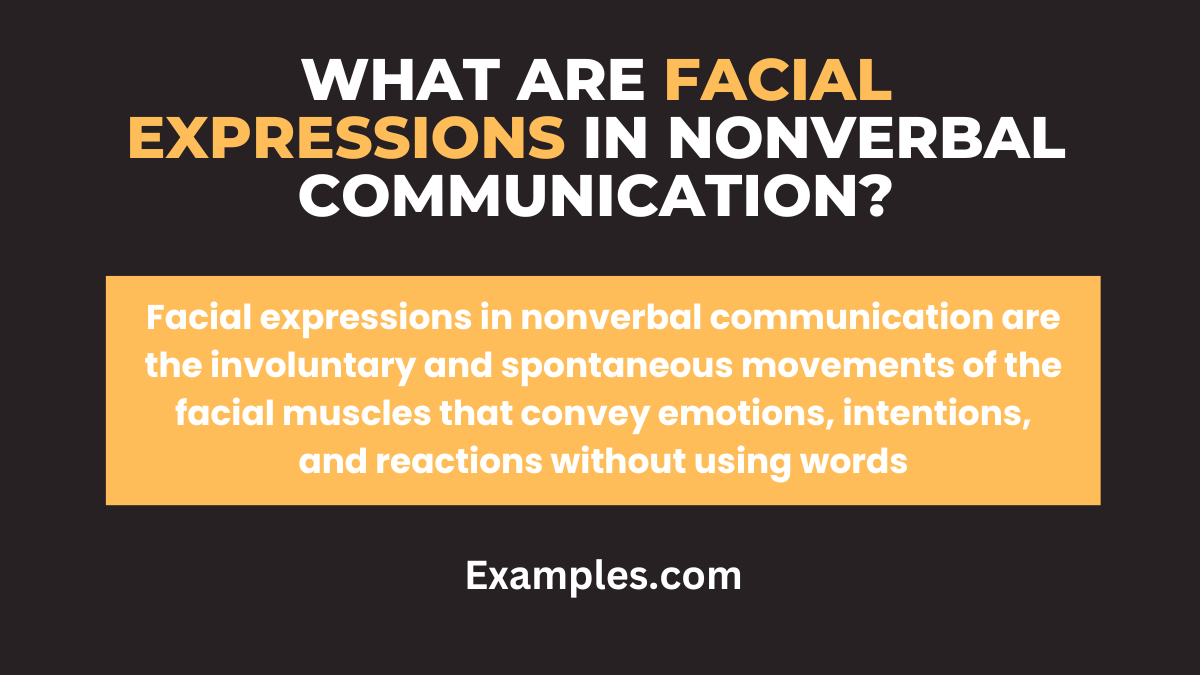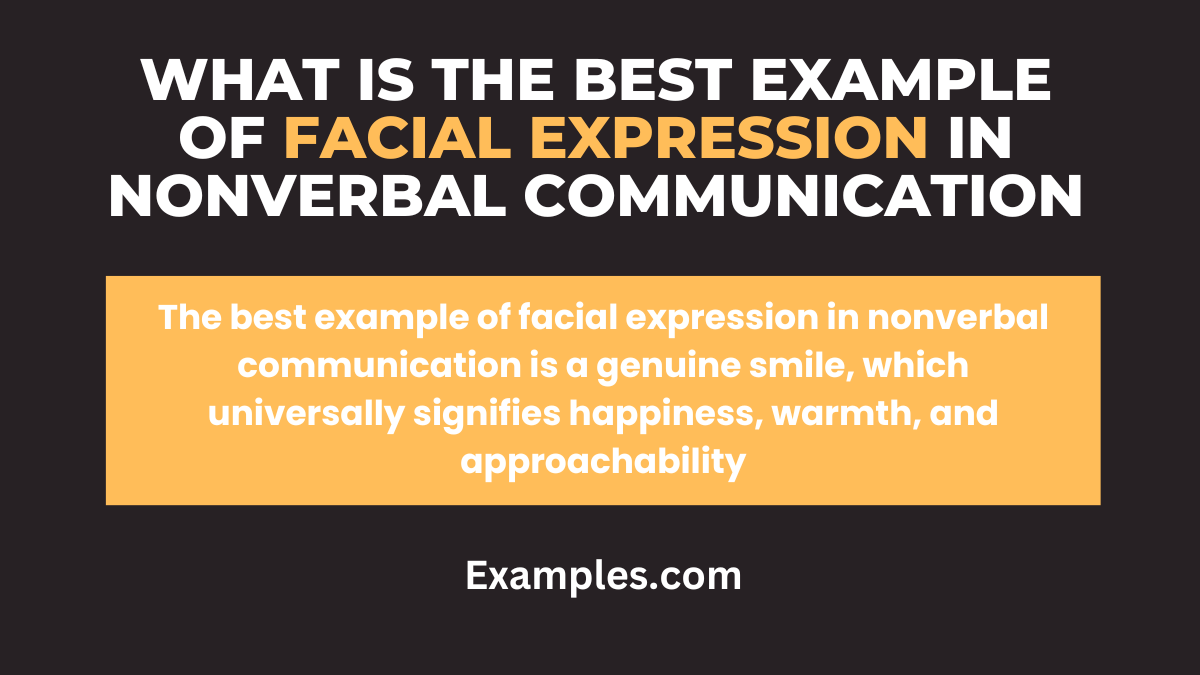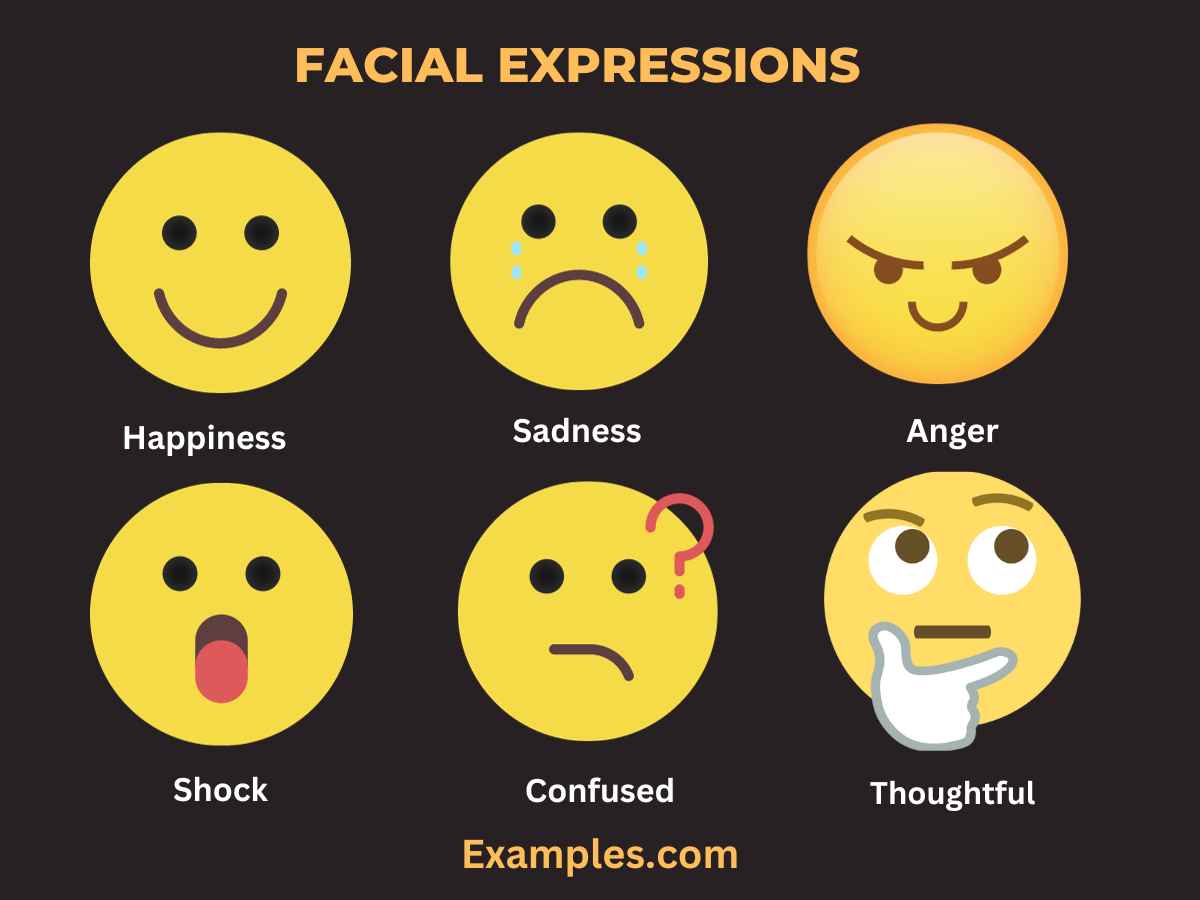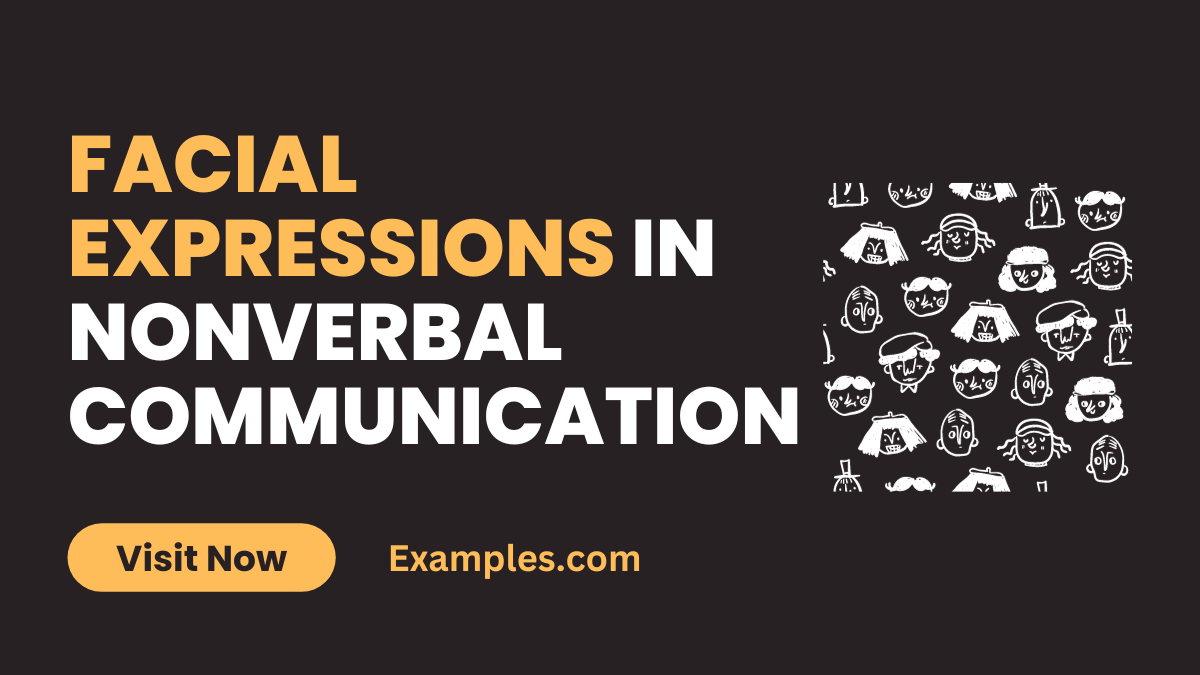29+ Facial Expressions in Nonverbal Communication Examples
Facial expressions in nonverbal communication play a crucial role in conveying emotions and intentions without words. This comprehensive guide delves into the nuances of facial expressions, highlighting their significance in interpersonal interactions. Understanding these silent cues is vital in both personal and professional settings, making this guide an essential read for anyone keen to enhance their communication skills.
What are Facial Expressions in Nonverbal Communication?
Facial expressions are a key component of nonverbal communication. They involve the movement and positioning of facial muscles to convey emotions, reactions, and intentions. Unlike verbal communication, which relies on words, facial expressions offer a more instinctual and universal method of communication. They can express a wide range of emotions, from happiness and surprise to anger and sadness. Recognizing and interpreting these expressions is a skill that enhances our understanding of others, transcending language barriers.

Importance of Facial Expressions in Nonverbal Communication
Facial expressions hold immense importance in nonverbal communication for several reasons. Firstly, they provide immediate feedback in interactions. For instance, a smile can indicate approval, while a frown may suggest disapproval or confusion. Secondly, they play a significant role in conveying emotions more effectively than words alone. For example, a genuine smile can convey warmth and friendliness, enhancing social bonds. Additionally, understanding facial expressions is crucial in professional settings, such as in nonverbal communication at the workplace, where they can reveal unspoken attitudes and help in navigating complex social dynamics. Recognizing these subtle cues enables better interpersonal understanding and fosters more effective communication.
What is the Best Example of Facial Expression in Nonverbal Communication?

Facial expressions are a pivotal aspect of nonverbal communication, often conveying emotions and intentions more powerfully than words. One of the most impactful examples of facial expressions in nonverbal communication is the display of empathy and understanding. When a person listens attentively and reflects appropriate facial responses—such as nodding slightly with a concerned expression when hearing sad news or smiling and raising eyebrows in surprise during a joyful story—they establish a deep, nonverbal connection. This silent yet expressive interaction not only conveys understanding but also builds trust and rapport between individuals.
The ability to accurately interpret and respond with facial expressions plays a critical role in interpersonal communication. For instance, a teacher who shows a warm, encouraging smile can boost a student’s confidence, while a manager’s stern, disapproving frown can effectively communicate dissatisfaction without a single word. In personal relationships, subtle expressions like a raised eyebrow or a gentle smile can speak volumes, conveying affection, skepticism, or agreement.
In professional settings, such as during job interviews or business meetings, facial expressions can significantly influence perceptions. A confident, open expression can project competence and readiness, whereas a puzzled or tense facial expression might suggest uncertainty or disagreement.
Understanding and mastering the art of facial expressions can greatly enhance one’s ability to communicate effectively in various social and professional contexts. By recognizing and appropriately responding to others’ facial cues, one can navigate complex emotional landscapes, fostering stronger, more meaningful connections.
30 Examples of Facial Expressions in Nonverbal Communication
Understanding facial expressions in nonverbal communication is crucial for effective interpersonal interactions. These expressions often convey more than words and play a significant role in conveying emotions, attitudes, and reactions. This article explores 30 distinct facial expressions, each a key aspect of nonverbal communication.

- Happiness: A bright smile with eyes crinkling at the corners, often accompanied by raised cheeks.
- Sadness: Down-turned mouth, drooping eyelids, and a downward gaze.
- Anger: Furrowed brows, narrowed eyes, and a tight, straight mouth.
- Surprise: Raised eyebrows, wide-open eyes, and a dropped jaw.
- Fear: Wide eyes, raised eyebrows, and a slightly open mouth.
- Disgust: Wrinkled nose, raised upper lip, and a look of aversion.
- Contempt: One side of the mouth raised slightly, with a dismissive glance.
- Interest: Bright, wide-open eyes, with a slight tilt of the head.
- Confusion: Furrowed brows, tilted head, and a slightly open mouth.
- Doubt/Skepticism: A raised eyebrow with a slightly tilted chin.
- Concentration: Narrowed eyes, pursed lips, and a slight frown.

- Boredom: A blank stare, with slightly drooping eyelids.
- Embarrassment: A flushed face with an averted gaze.
- Pain: A grimaced face with closed eyes and a clenched jaw.
- Shock: Wide eyes and mouth, with a frozen expression.
- Curiosity: Slightly raised eyebrows and a tilted head.
- Amusement: A suppressed smile with twinkling eyes.
- Sympathy: Soft eyes, with a slightly tilted head and a gentle smile.
- Pride: A lifted chin with a small, satisfied smile.
- Relief: A relaxed face with a slight, relieved smile.
- Desire: Intense gaze with partially opened lips.
- Jealousy: A tight smile with a sideways glance.
- Hope: Bright eyes with a gentle, optimistic smile.
- Indifference: A blank expression with a neutral mouth.
- Fatigue: Drooping eyelids and a sagging mouth.
- Flirtation: A coy smile with a sidelong glance.
- Resignation: Slightly down-turned mouth with a passive expression.
- Anticipation: Bright eyes with a slightly open mouth.
- Frustration: Tightened jaw, narrowed eyes, and a frown.

- Euphoria: An ecstatic smile with wide, bright eyes.
Role of Facial Expressions in Nonverbal Communication
Nonverbal communication forms a critical aspect of our daily interactions, often conveying more than words ever could. Among the various types of nonverbal communication, facial expressions stand out as a universal language, transcending cultural and linguistic barriers. They are the silent yet powerful communicators of our emotions, intentions, and reactions. In this comprehensive guide, we delve into the crucial role of facial expressions within the spectrum of nonverbal communication.
1. Understanding Facial Expressions in the Context of Nonverbal Communication
Facial expressions are spontaneous, often involuntary, movements of the facial muscles that convey an individual’s emotional state. They play a pivotal role in Nonverbal Communication Examples, offering a window into a person’s true feelings, sometimes even contradicting their verbal messages. This aspect is particularly relevant in understanding what percentage of communication is nonverbal. Studies suggest that a significant portion of our communication is nonverbal, with facial expressions being a key component.
2. The Universality of Facial Expressions
The universality of facial expressions is a fascinating aspect. Basic emotions such as happiness, sadness, anger, fear, surprise, and disgust are expressed similarly across various cultures. This universality enables a fundamental understanding of human emotions, making facial expressions a powerful tool in nonverbal communication.
3. Facial Expressions and Emotional Intelligence
Facial expressions are closely linked to emotional intelligence. The ability to accurately read and interpret these expressions is vital in social interactions. This skill aids in empathizing with others, resolving conflicts, and building stronger personal and professional relationships.
4. Impact of Facial Expressions in Various Spheres
- In Personal Relationships: Facial expressions often reveal unspoken emotions, helping partners understand each other better.
- In Professional Settings: Understanding and appropriately responding to the facial expressions of colleagues or clients can lead to more effective communication and business success.
- In Education: Teachers’ facial expressions can significantly impact students’ learning experiences, influencing their engagement and understanding.
5. The Synergy of Facial Expressions and Other Nonverbal Cues
While facial expressions are powerful, they often work in tandem with other nonverbal cues like body language, gestures, and eye contact. For instance, a smile combined with open body language and direct eye contact conveys warmth and openness, whereas the same smile with crossed arms might be perceived as insincere.
6. Challenges in Interpreting Facial Expressions
Despite their universality, interpreting facial expressions can be challenging. Cultural differences, personal experiences, and context play crucial roles in how facial expressions are displayed and interpreted. Misinterpretation can lead to misunderstandings in communication.
How to Use Facial Expressions in Nonverbal Communication?
1. Facial expressions
play a pivotal role in nonverbal communication. They can convey emotions, reactions, and intentions often more powerfully than words. Understanding how to effectively use facial expressions can enhance personal and professional interactions.
2. Recognize the Universal Expressions
Human faces are capable of displaying a wide range of emotions, including happiness, sadness, anger, surprise, fear, and disgust. Recognizing these universal expressions helps in understanding and empathizing with others.
3. Practice Mirror Exercises
To become more aware of your facial expressions, practice in front of a mirror. Observe how your face changes with different emotions. This self-awareness will help you control and use your expressions more effectively in social interactions.
4. Be Congruent
Your facial expressions should match your words and tone of voice. Incongruence can confuse or mislead the receiver. For instance, a smile while delivering a serious message can send mixed signals.
5. Pay Attention to Context
The context of a situation heavily influences the interpretation of facial expressions. For instance, a smile in one culture might be a sign of friendliness, while in another, it could be seen as inappropriate or a sign of nervousness.
6. Observe Others
Watch how others use facial expressions. People’s reactions in various situations can provide insights into the subtleties of facial expressions in nonverbal communication.
How can Facial Expressions Interfere with Nonverbal Communication?
Facial expressions are a crucial component of nonverbal communication, often conveying emotions and reactions without the need for words. However, they can sometimes interfere with the intended message in nonverbal communication, leading to misunderstandings or misinterpretations. This interference can occur in several ways.
1. Misreading Expressions
One common issue is the misreading of facial expressions. A smile, for instance, is generally associated with happiness or friendliness. However, in certain contexts, a smile might be a mask for discomfort, disapproval, or even sarcasm. Similarly, a frown doesn’t always signify anger; it can also indicate confusion or concentration. When people misinterpret these expressions, the intended nonverbal message is lost or altered.
2. Cultural Differences
Facial expressions can also vary significantly across different cultures. For example, in some cultures, direct eye contact is considered respectful, while in others, it might be seen as confrontational. Such cultural nuances can lead to misunderstandings in international or multicultural settings.
3. Over-Reliance on Facial Cues
Another issue is over-reliance on facial cues. While facial expressions are a key aspect of nonverbal communication, they are just one part of a broader spectrum that includes body language, gestures, and vocal tones. Focusing too much on the face can lead to neglect of other important nonverbal cues, resulting in a skewed understanding of the communication.
4. Inconsistency with Verbal Communication
Facial expressions can also interfere when they are inconsistent with verbal communication. For instance, if someone says they are fine but their facial expression shows distress, it creates confusion about the true message. This inconsistency can lead to distrust or uncertainty in communication.
5. Situational Misinterpretations
The context in which a facial expression is made also plays a significant role. A facial expression that is appropriate in one situation might be completely inappropriate in another. For instance, a casual smirk might be acceptable among friends but could be seen as disrespectful in a formal business meeting.
6. Managing Facial Expressions in Nonverbal Communication
To minimize interference in nonverbal communication through facial expressions, it is important to be aware of cultural differences, ensure consistency with verbal messages, and consider the context of the communication. Developing an understanding of how facial expressions can vary and how they are interpreted in different situations is crucial for effective nonverbal communication.
Tips for Facial Expressions in Nonverbal Communication
Using facial expressions effectively in nonverbal communication requires practice and awareness. Here are some tips to enhance your skills:
1. Be Authentic
Authenticity in your facial expressions builds trust. Forced or exaggerated expressions can seem insincere or manipulative.
2. Consider Cultural Differences
Facial expressions can have different meanings in different cultures. Nonverbal communication in different cultures requires sensitivity and understanding of these nuances to avoid miscommunication.
3. Use Eye Contact
Eye contact is a powerful component of facial expressions. It conveys confidence, sincerity, and engagement. However, be mindful of cultural norms regarding eye contact, as it varies globally.
4. Balance Expressiveness
While being expressive is important, too much expressiveness can be overwhelming or misinterpreted. Find a balance that is appropriate for the situation and the cultural context.
5. Reflect and Adapt
After social interactions, reflect on how your facial expressions were used and perceived. Adapting your nonverbal cues according to your experiences improves your communication skills.
Facial expressions are a crucial aspect of nonverbal communication examples. They complement, enhance, and sometimes even substitute verbal communication. Mastering the art of facial expressions can lead to more effective and empathetic communication.
For enhancing the content of your article on “Facial Expressions in Nonverbal Communication,” consider adding external links to reputable sources. A link to the American Psychological Association (https://www.apa.org) can provide readers with in-depth scientific insights into the psychology behind facial expressions. Additionally, incorporating a link to Harvard University’s research page (https://www.harvard.edu), specifically their studies on emotion and communication, would offer academic depth. For a practical and educational perspective, a link to the National Communication Association (https://www.natcom.org) can be valuable, as it offers resources and research on various aspects of communication, including nonverbal cues. These links will add substantial value to your audience by providing them with access to high-quality, authoritative content relevant to your article’s topic.



